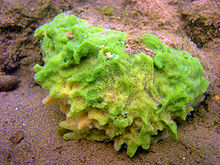| Spongilla lacustris | |
|---|---|

| |
| Scientific classification | |
| Domain: | Eukaryota |
| Kingdom: | Animalia |
| Phylum: | Porifera |
| Class: | Demospongiae |
| Order: | Spongillida |
| Family: | Spongillidae |
| Genus: | Spongilla |
| Species: | S. lacustris
|
| Binomial name | |
| Spongilla lacustris | |
| Synonyms | |
|
List
| |
Spongilla lacustris is a species of freshwater sponge from the family Spongillidae. It inhabits freshwater rivers and lakes, often growing under logs or rocks. Lacustris is a Latin word meaning "related to or associated with lakes".[1] The species ranges from North America to Europe and Asia. It is the most common freshwater sponge in central Europe.[2] It is the most widespread sponge in Northern Britain, and is one of the most common species of sponges in lakes and canals.[3] Spongilla lacustris have the ability to reproduce both sexually and asexually. They become dormant during winter. The growth form ranges from encrusting, to digitate, to branched, depending upon the quality of the habitat.[4]
- ^ Cocchiglia, Letizia; Purcell, Patrick J.; Kelly-Quinn, Mary (December 2012). "A Critical Review of the Effects of Motorway River-Crossing Construction on the Aquatic Environment". Freshwater Reviews. 5 (2): 141–168. doi:10.1608/frj-5.2.489. ISSN 1755-084X. S2CID 85723766.
- ^ "Fresh water sponge or spongilla lacustris". www.waterwereld.nu. Retrieved 2020-05-03.
- ^ Evans, Karen L.; Montagnes, David J. S. (September 2019). "Freshwater sponge (Porifera: Spongillidae) distribution across a landscape: Environmental tolerances, habitats, and morphological variation". Invertebrate Biology. 138 (3). doi:10.1111/ivb.12258. ISSN 1077-8306.
- ^ Manconi, Renata; Pronzato, Roberto (August 1991). "Life cycle of Spongilla lacustris (Porifera, Spongillidae): a cue for environment-dependent phenotype". Hydrobiologia. 220 (2): 155–160. doi:10.1007/BF00006548. ISSN 0018-8158. S2CID 44908383.